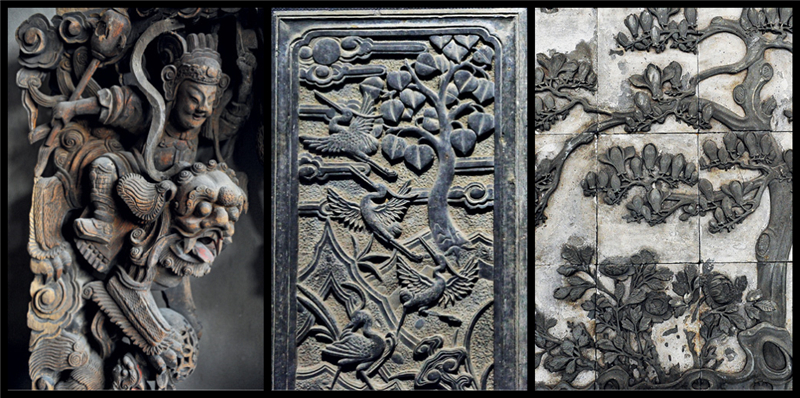
In the present day, Huizhou refers to the area covering Huangshan City of Anhui Province and Wuyuan County in Jiangxi Province. This historic region is renowned for its unique art of carving named after it. This craft is a sculpting skill applied in carving wood, brick, and stone for adornments. These sculptures are mainly used for decorations on houses, ancestral temples, religious shrines, gardens, and other constructions and for embellishments on traditional-style furniture, screens, writing brush holders, fruit bowls, as well as other folk crafts.
Huizhou carvings generally exhibt the themes of folklores, traditional plays, animals, flowers, and scenic landscapes, as well as traditions and customs. Most sculptures are carved in relief, while openwork, free-standing, intaglio, and other carving techniques are also applied. In 2006, Huizhou-style carving in wood, brick, and stone was listed as a national intangible cultural heritage item.
This carving style dates back to the Song Dynasty (960-1279) and flourished in the Ming (1368-1644) and Qing (1644-1911) dynasties. In early Ming Dynasty, Huizhou woodcarving style began to gradually take basic form; after the mid-Ming Dynasty, it evolved into carving of exquisite quality; by the time of the Qing Dynasty, sculpted motifs in Huizhou were exceedingly elaborate and complex with high aesthetic value. Lifelike patterns including buildings, flora and fauna, and human forms were usually carved in varied layers, sometimes even up to a dozen layers, all in one single brick, demonstrating an incredible level of artistry in carving.
Huizhou’s brick carving is usually used for architectural decoration and is normally carved in a type of greyish brick produced in Huizhou. Generally, Huizhou-style brick sculptures are carved in low and high relief, and are usually found on parts of a range of buildings like door casings, door panels, top rails, tiles, and eaves, rendering the construction stately and elegant.
Works of stone carving used to be ubiquitous in Huizhou, usually found on decorations of pillars, walls, doors, archways, and other parts of temples and residential buildings. Due to the texture of stone, this material depicts mainly flora and fauna, auspicious motifs, and calligraphies, but does not offer the flexibility of portraying as many themes as wood and brick.
Today, Huizhou-style carving inheritors set up workshops and studios offering apprentice training for preservation and application. In passing on old skills, Huizhou carvers are fusing modern elements into this traditional art to keep this sculpting expertise alive.